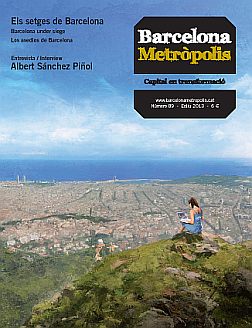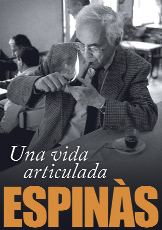- Una vida articulada [An articulated life]
- Josep M. Espinàs
- Edicions La Campana
- Barcelona, 2013
- 504 pages
In Una vida articulada, abridged and divested of all specific dates and titles, Espinàs’ articles have become like a mix of memoirs and chronicles, of miscellany and in the style of a practical philosophy book, in the best sense of the word. Having read the 500 pages – selected from a pile of 36 years, 11,000 columns – I can draw a couple of conclusions.
The first one is that Espinàs is the broad, functional and unavoidable bridge that unites the classic Catalan article writers – Carner, Sagarra and particularly Pla – and the writings of Monzó, Pàmies and Moliner: modern and civic article-writing, born of the society of abundance – with or without crisis – where common sense is permanently on guard against empty words and facile clichés, article-writing in an era of audiovisual and global audiences, availing itself of nuance rather than spectacle – and very often there is nothing more spectacular than nuance.
Espinàs eschews Pla’s vitriol and encyclopaedism; he is more naked, less bookish, but equally conservative. He has the same narrative skill, power of observation, of making absolutely the most of everything, of piquing your interest. He has the irony of that friend you wish was always at the table, which is why this book is something to savour. An utterly smooth read.
The second one is that these articles are all underpinned by a tenacious philosophy. A wisdom honed over numerous generations and the etymology of words and which, based on the innate scepticism of the newspaper, that permanent school of reality, leads us to an optimistic and convincing vision of human existence. Optimism lies at this book’s core. As of this, as Saint Thomas said, “good spreads itself”, and what more can you ask of a book?
Espinàs accomplishes all this by divesting the person of all transcendence, by putting him at the forefront of the composition. Not like the Romantics, who displaced the person, pushing him towards nature, but rather finding him in our vicinity, in civilised life, in our immediate setting, never far away. Espinàs is our special envoy to everydayness. Like a landing net that seeks out the imprecise silhouette of the human condition. Hence this fixation with immediate surroundings, with children, animals – particularly small ones – insects, trees and objects, details and the myriad of tiny things that comprise the environment where a person is forged: the circumstances that are our silhouette. Gratuitous things, because “free and gratuitous acts define the human being”. And that is so right: gratuity is the cornerstone of freedom. He barely has to move, things come to him, he is defined more by what he is not rather than by what he is, which is why he always says that when he sits down to write, his immediate environment disappears. Espinàs disappears, and thanks to that he becomes everyone’s mirror. Of course he disappears; he becomes the silhouette, the void, as if the world’s outline were his skin and as if the inner realities, the truly intimate ones – this fixation with time, for example, which shoots through us – as if the innermost and most intimate realities were on the outside. He thus describes the void that takes us in. A void with human form.
It is a trap we fall into gladly. However, the fact that it is anti-transcendental does not mean that it does not transcend. A void – an ambience – it is a mirror rather than a mould. We observe Espinàs the observer, we see ourselves in his “periodical exercise of depersonalisation”, we learn from him and we thank him, above all, for his example of serenity.




